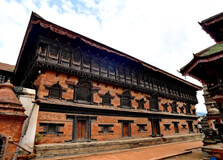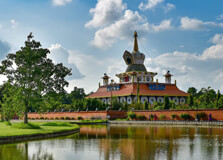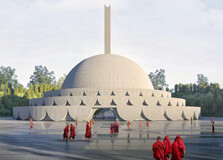
- ��Ӱֱ��
- Travel Packages
- Top Destination
-
Travel Attraction
By Category
Top Attraction

- Travel Agents
- Car Rentals
- Hotels

The 55 Windows Palace, also known as “Pachpanna Jhyal Durbar” in Nepali, is one of the most iconic and historical landmarks located in Bhaktapur, Nepal. This beautifully crafted palace is situated in the heart of Bhaktapur Durbar Square, a UNESCO World Heritage Site. It is famous for its artistic architecture, especially its 55 intricately carved wooden windows, which are considered masterpieces of Newar craftsmanship. Built during the reign of King Bhupatindra Malla in the 15th century and completed in the 18th century, the palace reflects the rich cultural and artistic heritage of the Malla era. How to Reach 55 Windows Palace, Bhaktapur Reaching the 55 Windows Palace is easy from Kathmandu and other nearby cities: The palace is located in Bhaktapur Durbar Square, about 13 kilometers east of Kathmandu. You can take a taxi, local bus, or microbus from Kathmandu, which takes around 30–45 minutes depending on traffic. Tourists staying in areas like Thamel or Patan can easily book a cab or a guided tour to reach Bhaktapur Durbar Square. Once you reach Bhaktapur, the palace is within walking distance inside the historic square. Weather at 55 Windows Palace, Bhaktapur Bhaktapur enjoys a moderate climate throughout the year. The best times to visit are: Spring (March to May): Pleasant and clear weather, perfect for sightseeing and photography. Autumn (September to November): Cool and dry with clear skies—ideal for tourists. Summer (June to August): Monsoon season, with rain and humidity. Carry an umbrella or raincoat if visiting during this time. Winter (December to February): Chilly mornings and evenings, but generally sunny during the day. Timing of 55 Windows Palace, Bhaktapur The palace and Bhaktapur Durbar Square are open every day to visitors. General visiting hours are: Opening Time: 7:00 AM Closing Time: 7:00 PM Morning visits are recommended to avoid crowds and enjoy peaceful exploration. Why is 55 Windows Palace Famous? The 55 Windows Palace is famous for its stunning example of traditional Newari woodwork. The 55 beautifully carved windows are its main attraction and are known as the finest woodcraft in Nepal. It served as the royal residence of the Malla kings of Bhaktapur. The palace is a symbol of art, culture, and the advanced architectural skills of the time. It is also a major part of the Bhaktapur Durbar Square complex, which includes temples, statues, and courtyards, drawing thousands of tourists and art enthusiasts every year. Entry and Visit Details about 55 Windows Palace, Bhaktapur Visitors need to pay an entry fee to access Bhaktapur Durbar Square, which includes entry to the 55 Windows Palace and surrounding monuments. For SAARC nationals: NPR 500 For foreign nationals: NPR 1,500 For Nepalese citizens: Entry is free The ticket is valid for one full day. There are guides available at the square, and you can hire one for a deeper understanding of the palace's history and architecture. History and Architecture of 55 Windows Palace The construction of the palace began during the reign of King Yaksha Malla in the 15th century and was later completed by King Bhupatindra Malla in the early 18th century. The palace was once used as the royal residence and administrative center. Its most unique feature—the 55 windows—were added as a symbol of grandeur and power. These windows are made of carved wood in intricate floral and geometrical patterns. The palace stands as a three-storied building with red-brick walls and a traditional sloped tile roof. The entrance to the palace is guarded by stone lions and leads to a beautifully maintained courtyard. Although parts of the palace are closed to the public for preservation, the exterior and the courtyard provide ample opportunity to appreciate its historic value. Things to Do at 55 Windows Palace Visiting the 55 Windows Palace is more than just viewing the windows. Here are things you can do: Admire the detailed wooden carvings and traditional architecture. Take photos of the iconic windows, doors, and courtyards. Explore the Bhaktapur Durbar Square and nearby temples such as Vatsala Temple and Nyatapola Temple. Visit the National Art Museum located within the palace complex. Watch local artisans and craftsmen work on wood, pottery, and paintings. Try local Newari dishes at nearby cafes and restaurants. Interesting Facts about 55 Windows Palace, Bhaktapur The palace is considered the finest example of 18th-century wood architecture in Nepal. It is said that the windows represent different expressions and moods, giving them symbolic meaning. The palace complex also houses the Taleju Temple, which is open only once a year during Dashain. The windows were carved from a single type of hardwood to maintain uniformity and durability. Despite suffering damage in earthquakes, restoration efforts have preserved its original charm. Tips for Visiting 55 Windows Palace, Bhaktapur Visit early in the morning or late afternoon to avoid the busiest crowds and get better lighting for photos. Hire a local guide to learn the history and legends associated with the palace and square. Wear comfortable walking shoes as the square is paved with stone and requires a lot of walking. Respect the cultural and religious norms—avoid climbing on statues or touching sacred areas. Don’t forget to explore the nearby markets for local handicrafts and souvenirs.
Explore More
The Great Drigung Kagyu Lotus Stupa
The Great Drigung Kagyu Lotus Stupa is a stunning and spiritually significant Buddhist structure located in the Lumbini Monastic Zone. Built by the Drigung Kagyu school of Tibetan Buddhism, this stupa symbolizes peace, enlightenment, and the essence of Buddha’s teachings. It is one of the most visually striking stupas in the area, known for its colorful design, intricate artwork, and deep spiritual atmosphere. Pilgrims and tourists alike visit this monument to meditate, offer prayers, and admire the remarkable Tibetan Buddhist architecture and symbolism it showcases. How to Reach The Great Drigung Kagyu Lotus Stupa, Lumbini The stupa is located in the Eastern Monastic Zone of Lumbini, near many other international monasteries. If you are already in Lumbini, the best way to get there is by foot, bicycle, or a cycle rickshaw. It is around 2 to 3 kilometers from the central Maya Devi Temple area and is well signposted. If you’re coming from outside Lumbini, the nearest airport is Gautam Buddha International Airport in Bhairahawa, approximately 22 kilometers away. You can hire a taxi or take a bus to the Lumbini Development Zone. From nearby Indian cities, you can cross the border at Sonauli and reach Lumbini by local transport or private cab. Weather in Lumbini Lumbini has a warm climate for most of the year. Summers (April to June) can be very hot, with temperatures reaching up to 40°C (104°F). The monsoon season (July to September) brings heavy rain and high humidity. The winter months (October to February) are the most pleasant, with temperatures between 8°C to 22°C (46°F to 72°F). The best time to visit the Great Drigung Kagyu Lotus Stupa is during the cooler months from October to March, when the weather is ideal for walking and sightseeing. Timing to Visit The Great Drigung Kagyu Lotus Stupa The stupa is open to visitors every day from 6:00 AM to 6:00 PM. It is recommended to visit early in the morning or later in the afternoon to avoid the heat and enjoy a peaceful experience. Sunrise and sunset are also beautiful times to witness the stupa glowing in natural light. Why is The Great Drigung Kagyu Lotus Stupa Famous? The Great Drigung Kagyu Lotus Stupa is famous for its grand design, spiritual energy, and detailed Tibetan Buddhist art. It is not only an architectural masterpiece but also a powerful place of meditation and prayer. The stupa was built to promote world peace, compassion, and mindfulness. It is considered one of the most important centers of the Drigung Kagyu lineage outside of Tibet. The striking colors, mandala-inspired structure, and spiritual importance make it a must-visit destination in Lumbini for both pilgrims and curious travelers. Entry and Visit Details There is no entry fee to visit the Great Drigung Kagyu Lotus Stupa. Visitors are welcome to explore the grounds, take photos (respectfully), meditate, or simply admire the beauty of the stupa and its surroundings. Shoes must be removed before entering the inner prayer areas, and modest clothing is required as a sign of respect. Quiet behavior is expected, especially in meditation zones. Visitors may also find monks or practitioners offering prayers and rituals, which can be quietly observed. History and Architecture The Great Drigung Kagyu Lotus Stupa was constructed by the Drigung Kagyu lineage, a school within Tibetan Buddhism, to commemorate the life and teachings of Lord Buddha and to spread messages of compassion and peace. The stupa's architecture follows traditional Tibetan Buddhist design, with a mandala-shaped base, multiple levels representing stages of enlightenment, and a large golden spire at the top. The exterior is beautifully painted in vibrant colors and adorned with sacred symbols, including prayer wheels, lotus motifs, and Dharma wheels. The stupa is surrounded by a peaceful garden, prayer flags, and smaller shrines. Inside, visitors will find murals, thangkas (Tibetan paintings), and statues of Buddha and other enlightened beings. Every part of the stupa's structure carries spiritual symbolism, reflecting deep teachings of Tibetan Buddhism. Things to Do at The Great Drigung Kagyu Lotus Stupa There are many meaningful and peaceful activities to enjoy during your visit: Walk clockwise around the stupa (a practice known as circumambulation) while spinning the prayer wheels. Sit in meditation or prayer in the quiet areas around the stupa. Observe Tibetan Buddhist rituals and ceremonies if they are being performed. Take respectful photos of the stupa’s detailed art and architecture. Learn about Tibetan Buddhist teachings by reading informational displays or speaking with resident monks (if permitted). Visit nearby monasteries in the Eastern Monastic Zone for a broader spiritual and cultural experience. Interesting Facts about The Great Drigung Kagyu Lotus Stupa The stupa is modeled after traditional Tibetan Buddhist stupas found in the Himalayas. It is one of the tallest and most visually detailed stupas in Lumbini’s Monastic Zone. The construction was guided by spiritual masters of the Drigung Kagyu lineage to ensure religious accuracy. Each level of the stupa symbolizes a different aspect of the Buddhist path to enlightenment. The surrounding prayer wheels are filled with sacred mantras to spread blessings with every spin. Tips for Visiting The Great Drigung Kagyu Lotus Stupa Dress modestly—wear clothes that cover your shoulders and knees. Remove your shoes before entering the stupa’s inner sacred spaces. Speak quietly and avoid using phones or cameras during meditation or rituals. Bring a bottle of water and wear comfortable walking shoes. Try to visit during early morning or late afternoon for the best lighting and cooler weather. If you don’t know how to use prayer wheels or walk around the stupa, observe others or ask respectfully. Be open to learning about Tibetan Buddhist traditions and symbolism—it adds depth to your visit.
Explore More
Ramagram Stupa is one of the most sacred and historically significant Buddhist sites located in Nawalparasi District, near the border of Kapilvastu, Nepal. This stupa holds special religious importance because it is believed to enshrine one of the original relics (remains) of Lord Buddha. According to Buddhist texts, after the Buddha’s cremation, his relics were divided among eight kingdoms. The Ramagram Stupa is said to be the only stupa that has remained untouched and unopened since ancient times. Surrounded by lush green landscapes and peaceful rural settings, Ramagram is a serene place for spiritual reflection, historical study, and pilgrimage. The site has gained global recognition and is considered part of the extended Buddhist Circuit that includes Lumbini, Kapilvastu, and other related sites. How to Reach Ramagram Stupa, Kapilvastu Reaching Ramagram Stupa is relatively easy due to its proximity to Lumbini and Kapilvastu. It lies in the Nawalparasi district but is often visited as part of the Kapilvastu Buddhist pilgrimage. By Air: The nearest airport is Gautam Buddha International Airport in Bhairahawa, located about 45–50 kilometers away. Taxis or local buses are available from the airport. By Road: Ramagram can be accessed by road from Butwal, Bhairahawa, Lumbini, or Taulihawa. Local buses and private vehicles are commonly used. From Lumbini: The distance is around 40 kilometers and can be covered in approximately 1.5 hours by car. From Kapilvastu: Ramagram can be reached in about 2 hours by road as part of a heritage circuit tour. Weather and Best Time to Visit Ramagram Stupa is located in the Terai region of southern Nepal, which has a tropical climate. The weather can be hot and humid, especially in summer. Spring (March to May): Warm and dry weather makes this a good time to visit. Flowers are blooming, and the landscape is beautiful. Monsoon (June to August): Heavy rain can cause muddy paths and discomfort. Not the best season for outdoor travel. Autumn (September to November): Ideal time with clear skies, pleasant temperatures, and vibrant nature. Best time for pilgrimage and photography. Winter (December to February): Cool and foggy mornings with comfortable daytime temperatures. Good for travel with warm clothing. Why is Ramagram Stupa, Kapilvastu Famous? Ramagram Stupa is world-renowned for being the only undisturbed original relic stupa of Lord Buddha. This unique status gives it immense religious and archaeological value. Original Buddha Relic: According to Buddhist tradition, one of the eight portions of Buddha’s relics was placed in this stupa by the Koliya clan, and it has remained unopened for over 2,500 years. UNESCO Interest: Ramagram is under consideration for UNESCO World Heritage Site status as part of the Lumbini Sacred Garden expansion. Spiritual Energy: Monks, pilgrims, and spiritual seekers visit this site for meditation and prayers, believing it has pure spiritual power. Archaeological Value: Excavations have confirmed the presence of ancient layers and relic-related artifacts, making it significant for researchers and historians. Entry and Visit Details Ramagram is a peaceful, open-air archaeological and spiritual site. Visitors are welcome throughout the year. Entry Fee: Currently, there is no entry fee to visit the Ramagram Stupa. Opening Hours: Open daily from sunrise to sunset. It is best to visit between 6:00 AM and 6:00 PM. Visitor Guidelines: Photography is allowed. Visitors are requested to be respectful, maintain silence, and not climb the stupa. Facilities: Basic amenities like restrooms and seating are available. Small shops and tea stalls can be found nearby. History and Architecture Ramagram Stupa dates back to the 6th century BCE and is one of the eight original stupas built after the cremation of the Buddha. The Koliya tribe, maternal relatives of the Buddha, were responsible for building this stupa to preserve their share of relics. The structure is a simple, mound-shaped stupa, largely unaltered since its creation. This untouched nature makes it incredibly valuable from both historical and religious viewpoints. The surrounding site includes remains of ancient walls, a Bodhi tree planted by devotees, and stone pathways that may have been used by pilgrims in earlier centuries. Unlike other stupas that have been expanded or rebuilt, Ramagram maintains its original form. Efforts are being made by heritage organizations to preserve the natural and spiritual purity of the site. Things to Do at Ramagram Stupa Spiritual Meditation: Many visitors sit under the Bodhi tree near the stupa to meditate or pray in silence. Walking Around the Stupa: Pilgrims walk around the stupa clockwise, a traditional Buddhist practice known as circumambulation. Photography: The peaceful environment and ancient architecture offer excellent photography opportunities. Learn from Monks: If you visit during special Buddhist festivals or ceremonies, you may find monks and teachers giving talks or leading prayers. Visit Nearby Villages: Explore local life, traditional houses, and local food in surrounding rural areas. Facts and Tips about Ramagram Stupa, Kapilvastu Ramagram is the only stupa among the original eight that has never been opened or disturbed. It is believed that Emperor Ashoka tried to open it but stopped when a serpent deity protected the relics. The area is quiet, peaceful, and less crowded than Lumbini, making it perfect for deep spiritual visits. No commercial development is allowed near the site to preserve its original natural setting. Carry your own drinking water, especially in summer months. Dress modestly and behave respectfully, as this is a sacred religious site. If you are doing a full Buddhist pilgrimage, combine this visit with Tilaurakot, Gotihawa, and Lumbini. Sunrise and sunset offer beautiful lighting for photography and peaceful reflection.
Explore More